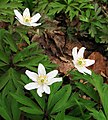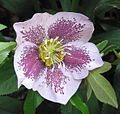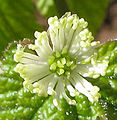| Ranunculaceae Temporal range: Cretaceous–Recent[1] | |
|---|---|
 | |
| Ranunculus auricomus (type species) | |
| Scientific classification | |
| Kingdom: | Plantae |
| (unranked): | Angiosperms |
| (unranked): | Eudicots |
| Order: | Ranunculales |
| Family: | Ranunculaceae Juss. |
| Subfamilies | |
Ranunculaceae (buttercup or crowfoot family; Latin rānunculus "little frog", from rāna "frog") are a family of about 1700 species of flowering plants in about 60 genera, distributed worldwide.
The largest genera are Ranunculus (600 species), Delphinium (365), Thalictrum (330), Clematis (325), and Aconitum (300).
Contents[hide] |
[edit]Description
Ranunculaceae are mostly herbaceous plants, but with some woody climbers (such as Clematis) and subshrubs (e.g.Xanthorhiza).
Members of the Ranunculaceae usually have five colored sepals instead of petals (except buttercups), and divided leaves and nonwoody tissue (except clematis). [1] Leaves are usually divided or lobed, but are heart-shaped or narrow and undivided in some species of Ranunculus, and usually arise from the base of the plant, or alternately up the stem, but in Clematis they are opposite. Perennial species form a small rhizomes or tubers which develop new roots each year.
Flowers may be solitary, but are frequently found aggregated in cymes, panicles or spikes. Many species have no true petals, and the 'flower' is formed by a brightly colored calyx. There are usually five sepals, although there are many which come in a wide variety of shapes. Ranunculus (buttercups) is the only genus in this family with a true calyx and petals. There are many stamens surrounding many fused carpels.
The fruit is most commonly a follicle (e. g. Helleborus, Nigella) or an achene (e. g. Ranunculus, Clematis).
Ranunculaceae contain protoanemonin, which is toxic to humans and animals. Other poisonous or toxic compounds,alkaloids and glycosides, are also very common.
[edit]Taxonomy
The family Ranunculaceae is included in the Ranunculales which is the sole order of the Ranunculanae, a superorder of eudicots according to APG 3 systematics. The phylogeny is well illustrated in [2]
[edit]Taxonomic comparisons
According to Dr John David, (2010)[3] the Ranuculaceae are combined with the Eupteleaceae, Lardizabalaceae, Menispermaceae, Berberidaceae, and Papaveraceae in the Ranunculales, the only order in the superorder Ranunculanae. This follows the work of the Angiosperm Phylogeny Group.
Takhtajan 1997 includes the Ranunculaceae as the only family in the Ranunculales which he placed in a subclass, the Ranunculidae, instead of a superorder. Previously, Thorn 1992 placed the Ranunculaceae in the Berberidales, an order within the Superorder Magnolianae. Earlier Cronquist in 1981 included the Ranunculaceae along with seven other families in the Rancunculales which was included in the Magnoliidae, which he regarded as a subclass.[4]
The cladogram below is according to the APG II system, based on molecular phylogeny.
| |||||||||||||||||||||||||
The genus Glaucidium was once put in its own family (Glaucidiaceae), but has been recently recognised as a primitive member of Ranunculaceae. Tamura (1993) recognised five subfamilies, mainly based on chromosomic and floral characteristics (Hydrastidoideae, Thalictroideae, Isopyroideae, Ranunculoideae, Helleboroideae).
Hydrastidoideae and Glaucidioideae have only one species, Hydrastis canadense and Glaucidium palmatum respectively. Coptoideae has 17 species and Thalictroideae has 450, including Thalictrumand Aquilegia. The other genera (2025 species, 81% of the family) belong to Ranunculoideae.
Some older classifications included Paeonia (peony) in Ranunculaceae but this genus is now placed in its own family, Paeoniaceae in order Saxifragales. Circaeaster and Kingdonia are now placed inCircaeasteraceae.
[edit]Fossil record
Fossils of fruits, pollen, seeds, and leaves are known from several dozen locations. The fossil record begins in the early Cretaceous and continues throughout the Tertiary. In most cases, the fossils are assigned to extant genera, or show a close relationship to a particular extant genus.[1]
[edit]Uses
Some Ranunculaceae are used as herbal medicines because of their alkaloids and glycosides, such as Hydrastis canadensis (goldenseal), whose root is used as a tonic.
Many genera are well known as cultivated flowers, such as Aconitum (monkshood), Consolida (larkspur), Delphinium, Helleborus (Christmas rose), Trollius (globeflower).
The seeds of Nigella sativa, are used as a spice in Indian and Middle Eastern cuisine.
[edit]Genera
|
|
|
|
|
|
|
[edit]Gallery
[edit]Flowers
[edit]Fruit
[edit]Follicle | [edit]Achene |
























No comments:
Post a Comment